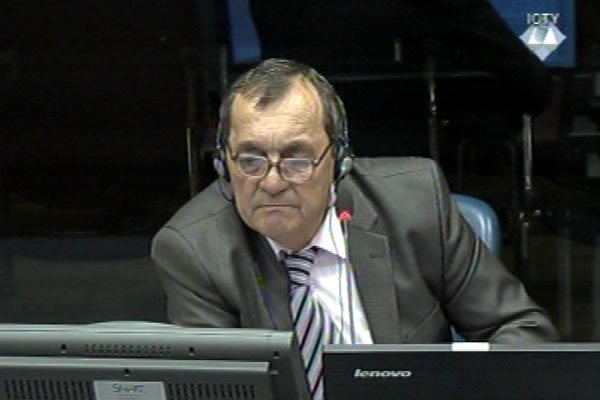Home
NEIGHBORS COMMUNICATING OVER GUN SIGHTS
In his evidence in Mladic’s defense, former commander of the Mrkovici Platoon says his soldiers warned their neighbors in Sedrenik not to mow the grass or collect hay when the visibility was good to protect them from possible Serb fire. The prosecution suggested that his ‘concerns materialized’ when the neighbors from Sedrenik were targeted by snipers from Spicasta Stijena
 Blasko Rasevic, defence witness at Rako Mladic trial
Blasko Rasevic, defence witness at Rako Mladic trial In the first part of today’s hearing at the trial of Ratko Mladic, Sinisa Maksimovic, a Bosnian Serb military officer, completed his evidence. The next witness was Blasko Rasevic. In the summer of 1994, Rasevic replaced Maksimovic as the commander of the Mrkovici platoon. The unit held positions near the village of Mrkovici. The most important site under their control was Spicasta Stijena. As alleged by the prosecution, snipers terrorized parts of Sarajevo from that location.
In his statement to Mladic’s defense Rasevic said that he never received or issued any orders to fire on civilians in the city. His unit, Rasevic stated, had only defensive tasks and never engaged in offensive operations. Also, according to Rasevic, his unit was targeted by sniper attacks and the BH Army from the city attacked them with mortars mounted on trucks. The crews would open fire from the trucks and then shelter behind schools, kindergartens and hospitals.
In the brief examination-in-chief the defense presented excerpts from a video recording showing the attack of the Black Swans unit on Spicasta Stijena in the summer of 1994. The Black Swans was a BH Army special unit. The Mrkovici Platoon lost the position for a couple of hours in the attack because the Bosnian specials were able to hold the Serb trenches for an entire night.
Prosecutor Arthur Traldi put it to the witness that there was a ‘good view’ of Sarajevo from Spicasta Stijena. The witness replied that ‘only a part of the city’ could be seen from there: Sedrenik and its surroundings, Sirokaca, Zlatiste and a little bit of Bascarsija. The civilians who lived in Sedrenik were so close to the Serb positions that the soldiers serving in the witness’s unit talked to their acquaintances from the village. The soldiers warned the civilians not to collect hay when the visibility was good. As the witness explained, they did so in a bid to protect the villagers from the Serb fire, because ‘someone could have gotten an idea to kill an innocent man’.
The prosecutor put it to him that his concerns materialized: the civilians in Sedrenik really did come under fire at one point. Rasevic replied that it didn’t happen while he was the platoon commander. He did admit that he heard about an incident in which a girl was injured. ‘I am very sorry for every child, but I don’t know anything about it because I wasn’t there at the time’, the witness noted. It remained unclear which incident Rasevic had in mind. He may have referred to the wounding of three-year old Anisa Pita in front of a house in the Sirokaca neighborhood on 13 December 1992. The incident is listed in the indictment against Mladic.
Describing the conversations ‘over the gun sights’ Rasevic said the soldiers of the Serb Army and the BH Army would communicate regularly while they were in trenches.
The Mrkovici platoon was part of the Hresa Battalion. The position Zecja Glava was in the unit’s area of responsibility. The prosecution alleges that during the war non-Serb civilians were brought by buses from the Serb-controlled territories to Zecja Glava and were then deported to the part of Sarajevo under siege. Rasevic confirmed it, adding that he heard that the Muslim civilians were brought to the demarcation line ‘at their behest’ and then went on to Sarajevo. Blasko Rasevic will continue his evidence tomorrow.
Linked Reports
- Case : Mladic
- 2014-07-04 WITNESS: ‘MUSLIMS STAGED MARKALE 1’
- 2014-07-03 WHO TERRORIZED WHOM IN SARAJEVO
- 2014-06-27 MILITARY TARGET MISSED OR CIVILIAN TARGET HIT?
- 2014-07-08 DEFENDING ‘LIVING SPACE’
- 2014-07-09 MLADIC’S WITNESS: SERBS ARE GENETICALLY STRONGER, BETTER, HANDSOMER AND SMARTER
- 2014-07-10 NENAD KECMANOVIC WAS DELUDED FOR TWENTY YEARS
